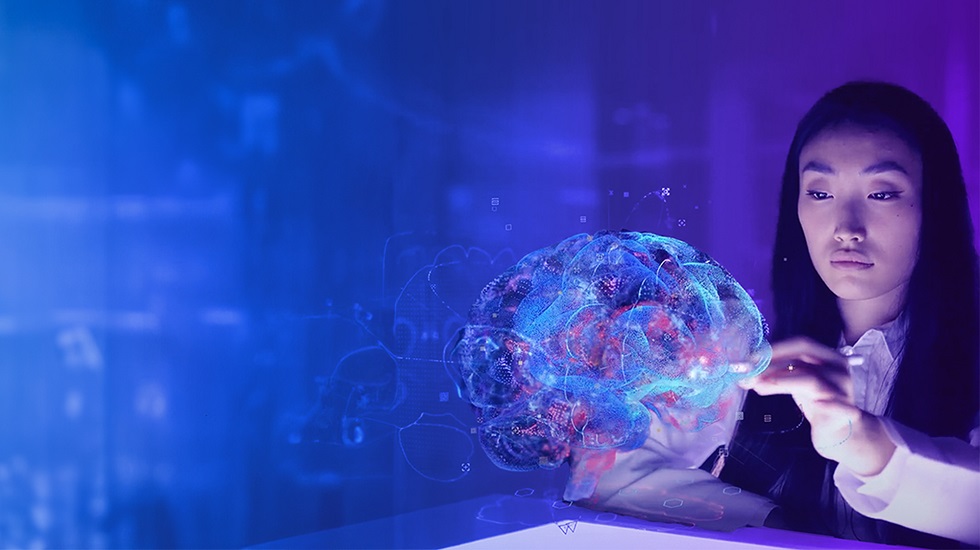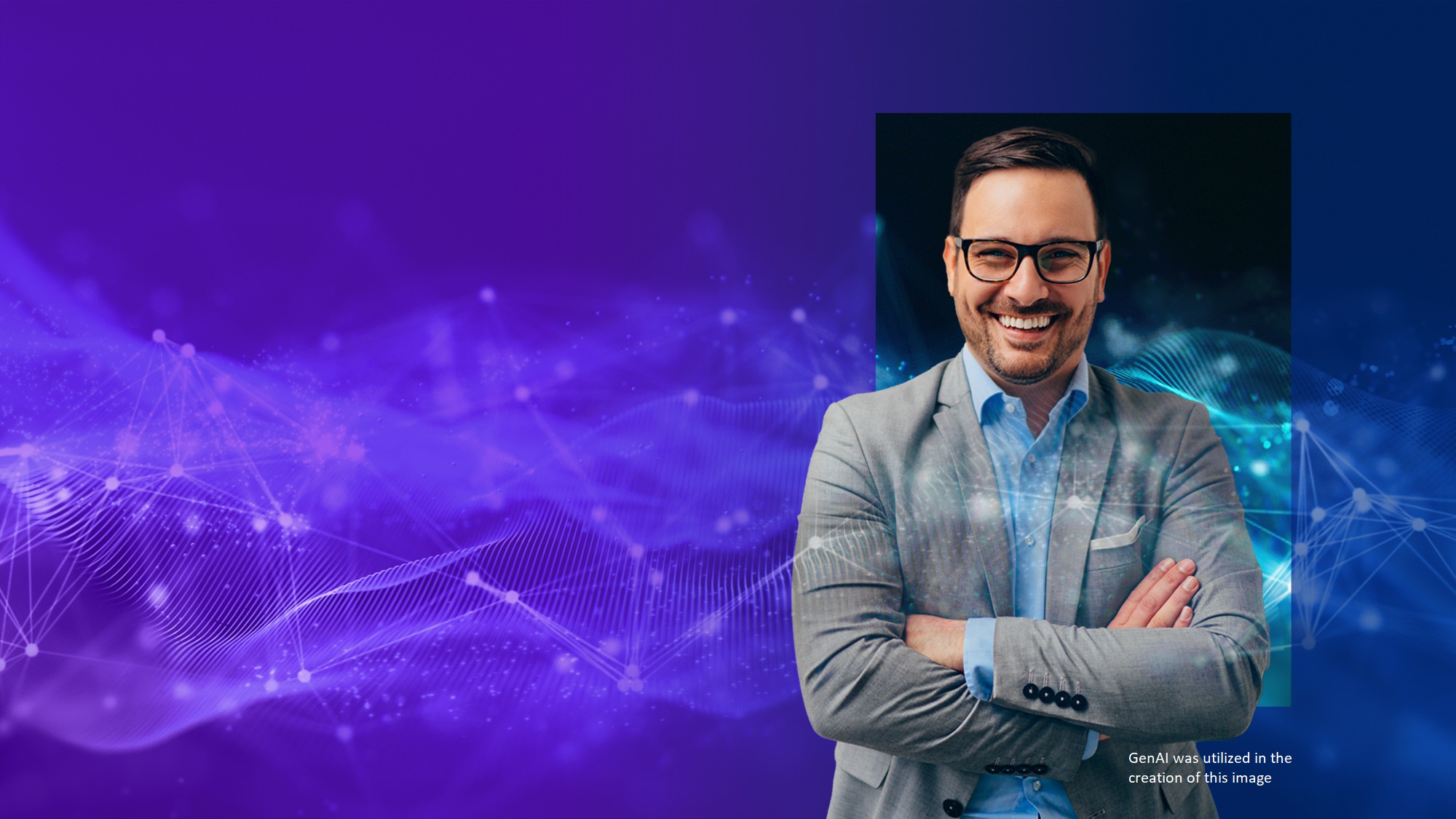What’s Your aIQ?
How to ensure your AI transformation puts humans first

A primer on human-centric AI
This article on human-centric artificial intelligence (AI) is the second in our ongoing "What’s Your aIQ?" series, which provides KPMG insights on the most essential issues on clients’ minds as we navigate the AI era. Our insights are backed up by learnings from our internal aIQ journey, thus ensuring we share practical, tested solutions that add tangible value. In this piece, we share insights on why humans should be at the center of AI-related decisions and how organizations can employ AI as an enabler of human talent.
Which came first, the human or the bot? While the answer to that one may be obvious, the trickier question is: When it comes to AI transformation, which is more important?
Although it may seem counterintuitive, the answer is humans. AI may have an unprecedented ability to organize and analyze data. But it is the intersection of AI with human ingenuity and critical thinking that makes the real difference. The true value of AI is realized when organizations use it to complement and enhance human skills rather than replace them.
Organizations can reap the best of human intelligence and AI by:
1. Taking a human-centric approach to AI adoption
Adopting AI is not about the wow factor, although that is undeniably a large part of what is driving the AI frenzy. It is about using the technology’s revolutionary capabilities across the enterprise to improve the employee experience and create more productive, efficient, and innovative workers. From administrative roles to knowledge workers to the C-suite, there are limitless opportunities to use AI to enhance roles, transform jobs, and create new opportunities.
Leadership may have shifted to this mindset. But do employees get it? Maybe not. With all the media outcry about AI replacing jobs, there is understandable fear and anxiety across the workforce. Therefore, it is urgent to communicate to your employees that AI is a tool for enhancing human capabilities, not displacing them. Employees need to understand that, even as AI takes on more routine tasks, they have an indispensable role to play in oversight, decision-making, and critical thinking. At the same time, the reality is that individuals who are conversant in AI are likely to outperform peers who aren't, which should serve as a motivator for employees to get on board.
It is also important to tailor communications based on roles, levels, and AI maturity. Leadership should get to know individuals in different types of roles across the workforce and communicate to them based on personas that reflect what motivates them—just as you would do with customers. In this way, you can better understand how to get employees on board with what could be the most sweeping change in their career histories.
Lessons from the KPMG aIQ journey
At KPMG, we take an omni-channel approach to communicating with employees about what AI means for the firm and, more important, what it means for them. The result is a sense of “surround sound” through which employees are ensconced in a holistic AI-forward environment. We do this by:
- Offering regular updates on AI progress across the firm and in particular practices via communication channels such as newsletters and emails.
- Exploring more creative and engaging modes of communication, including gamification; competitive ideation challenges; and efforts targeted to specialized communities, including functions, industries, and employee resource groups.
- Using creative storytelling and sharing of “aha moments” across the organization that highlight specific and tangible stories of how AI is driving value with clients and in everyday work.
- Leveraging social and community networks to encourage employees to share ideas and experiences.
2. Identifying roles that can be augmented with AI
Although productivity gains and time savings are worthwhile, organizations that only focus on modest short-term gains will miss out on longer-term opportunities to create new business models and generate new revenue streams. Envisioning the big picture requires a more holistic, cross-functional approach to AI adoption that comprises “new” jobs enabled by the technology—jobs that might not necessarily align with traditional ways of working.
To get started, organizations need to take a deep dive into roles, capabilities, and enablers across the enterprise. Identifying roles and tasks that are ripe for AI enablement will lead to significant streamlining and/or optimization of roles that will allow your organization to capture new value. While the most value may come from augmenting revenue-producing roles with AI, you can also realize meaningful cost-savings by automating routine tasks so that employee hours are freed up for more creative work.
This level of workforce transformation fundamentally alters how employees engage with their work, the nature of their daily tasks, and even the amount of time spent working. Such profound changes are not only operational but also cultural. As employees experience a shift in how they feel about their work and their place within the organization, robust people and change efforts are critical.
Lessons from the KPMG aIQ journey:
At KPMG we believe the success of our human-centric AI journey relies on organic adoption, driven by the entire workforce's collective effort and engagement. To this end, we are:
- Rethinking and adapting our talent strategies to align with AI-enabled roles.
- Deconstructing and reconstructing roles at all levels to allow for effective AI enablement.
- Fostering a collaborative environment that is conducive to embracing new AI-driven opportunities.
- Evaluating today’s day-to-day roles and identifying new roles that didn’t exist prior to AI.
3. Investing in hands-on learning and upskilling
The concept of upskilling shifts when we are talking about AI. Instead of taking advanced technology training, like you might do with a new piece of software, upskilling in the age of AI focuses on new job tasks made possible when routine tasks are automated by AI. Organizations need to communicate this message—and communicate it again and again—since knowledge workers who adopt GenAI are going to outperform knowledge workers who don’t. The more workers who elevate their strategic thinking, enhance their skills, and improve their decision-making, the stronger your company will be in an AI-forward future.
Also critical is establishing a common vocabulary as a foundation for the entire workforce. Once that work has taken hold, personalize the learning experience so that courses meet individuals where they are, reflecting their AI maturity and technical skill level. Hands-on learning experiences where employees can interact with AI tools are of much greater value than “book learning.” This approach allows individuals to experience first-hand how AI fits into their particular set of responsibilities and working styles. Ultimately, organizations should provide every person in every function a chance to experiment responsibly to unlock potential use cases, garner feedback for refining applications, build the technology into planning cycles, and eventually contribute to transforming the organization’s business model.
Lessons from the KPMG aIQ journey:
Our KPMG’s comprehensive training program, aimed at equipping all KPMG partners and employees with AI skills, serves as a model for clients. Our approach to training and upskilling comprises:
- Implementing a comprehensive and continually updated set of courses that include AI literacy and hands-on workshops.
- Developing AI-focused groups and events that foster a sense of community and collective learning.
- Offering employees access to tools that allow them to experience AI’s benefits and be more productive immediately.
- Integrating AI training into the natural workflow to foster a culture of continuous learning and curiosity that drives long-term innovation and growth.
We envision a future where there is seamless collaboration between humans and AI, not competition. By focusing on a human-centric approach to AI adoption, transformation of roles that can be augmented by AI, and immersive learning experiences, organizations can leverage AI to enhance human capabilities rather than diminish them. At KPMG, our commitment to this approach is not only about leading by example, but also about equipping our clients with the knowledge and tools to ensure their AI transformations put humans first.
Put AI into Action
KPMG is at the forefront of AI strategy, offering the Trusted AI framework—a comprehensive guide for businesses ready to enhance their AI capabilities
Explore more
Get the latest thinking from KPMG on artificial intelligence and machine learning.

Leading the charge on AI with a Chief AI Officer
A Chief AI Officer drives ethical AI integration, unlocks transformative growth, and sets a new digital standard for the enterprise.

Accelerating revenue in the age of Generative AI
Explore GenAI’s impact on revenue-generating teams from boosting productivity and improving experiences to reducing cost of sales.

Accelerating generative AI success by activating change
The biggest risk with adoption may not be what you think.